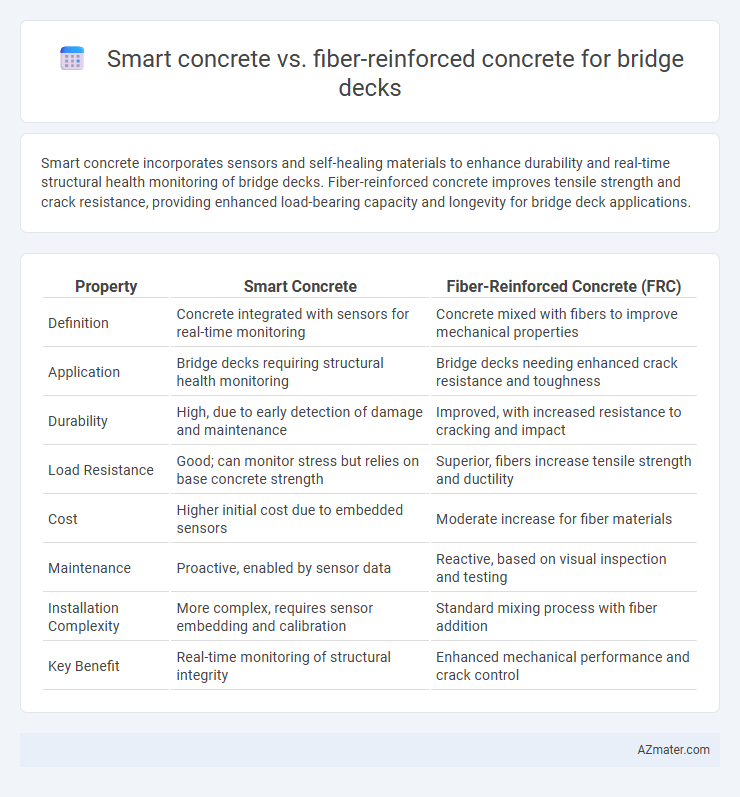Smart concrete incorporates sensors and self-healing materials to enhance durability and real-time structural health monitoring of bridge decks. Fiber-reinforced concrete improves tensile strength and crack resistance, providing enhanced load-bearing capacity and longevity for bridge deck applications.
Table of Comparison
| Property | Smart Concrete | Fiber-Reinforced Concrete (FRC) |
|---|---|---|
| Definition | Concrete integrated with sensors for real-time monitoring | Concrete mixed with fibers to improve mechanical properties |
| Application | Bridge decks requiring structural health monitoring | Bridge decks needing enhanced crack resistance and toughness |
| Durability | High, due to early detection of damage and maintenance | Improved, with increased resistance to cracking and impact |
| Load Resistance | Good; can monitor stress but relies on base concrete strength | Superior, fibers increase tensile strength and ductility |
| Cost | Higher initial cost due to embedded sensors | Moderate increase for fiber materials |
| Maintenance | Proactive, enabled by sensor data | Reactive, based on visual inspection and testing |
| Installation Complexity | More complex, requires sensor embedding and calibration | Standard mixing process with fiber addition |
| Key Benefit | Real-time monitoring of structural integrity | Enhanced mechanical performance and crack control |
Introduction to Advanced Bridge Deck Materials
Smart concrete incorporates sensors and self-healing properties, offering real-time monitoring and enhanced durability for bridge decks. Fiber-reinforced concrete improves tensile strength and crack resistance through the integration of synthetic or steel fibers, enhancing structural performance under heavy loads. Both materials contribute to extending service life and reducing maintenance costs in advanced bridge deck construction.
Defining Smart Concrete: Features and Functions
Smart concrete integrates self-sensing capabilities through embedded sensors or conductive materials, enabling real-time monitoring of strain, temperature, and structural health in bridge decks. This advanced material responds dynamically to environmental changes and stress, allowing early detection of cracks and deterioration before visible damage occurs. Unlike fiber-reinforced concrete, which primarily enhances mechanical strength and crack resistance, smart concrete combines strength with intelligent data collection for proactive maintenance and safety management.
Understanding Fiber-Reinforced Concrete
Fiber-reinforced concrete (FRC) enhances bridge deck durability by integrating synthetic or steel fibers that improve tensile strength, impact resistance, and crack control compared to traditional concrete. This reinforcement reduces maintenance costs and extends the lifespan of bridge decks by mitigating common issues like fatigue and spalling under heavy traffic loads. Understanding the material properties and fiber types--such as steel, glass, or polypropylene--is crucial to optimizing FRC performance in bridge deck applications.
Comparative Structural Performance
Smart concrete exhibits superior self-healing properties and enhanced durability under cyclic loading compared to fiber-reinforced concrete, which primarily improves tensile strength and crack resistance. The integration of sensors in smart concrete enables real-time structural health monitoring, offering predictive maintenance advantages absent in fiber-reinforced variants. Fiber-reinforced concrete often demonstrates higher flexural strength and energy absorption, making it effective against impact and fatigue, but lacks the autonomous repair capabilities critical for extending bridge deck service life.
Durability and Longevity Analysis
Smart concrete incorporates self-healing materials and sensors that detect micro-cracks, enhancing durability by preventing early-stage damage in bridge decks, thereby extending service life. Fiber-reinforced concrete improves tensile strength and crack resistance through dispersed fibers, reducing crack propagation and increasing longevity under dynamic loads. Comparative studies reveal smart concrete offers superior long-term performance through proactive damage management, while fiber-reinforced concrete provides robust structural integrity against mechanical stresses.
Crack Detection and Self-Healing Capabilities
Smart concrete embedded with sensors offers real-time crack detection for bridge decks, enhancing maintenance efficiency and safety monitoring. Fiber-reinforced concrete improves structural integrity by limiting crack propagation but lacks inherent self-healing or active damage detection capabilities. Combining smart concrete's sensing technology with fiber reinforcement optimizes durability and early crack identification in bridge deck applications.
Cost Efficiency and Maintenance Requirements
Smart concrete integrates sensors for real-time structural health monitoring, reducing long-term maintenance costs by enabling early damage detection, whereas fiber-reinforced concrete enhances durability and crack resistance, lowering initial repair needs but lacks built-in monitoring capabilities. The initial cost of smart concrete is higher due to embedded technologies, while fiber-reinforced concrete offers a more affordable upfront investment with moderate maintenance savings. Over the lifespan of a bridge deck, smart concrete's predictive maintenance can significantly minimize costly interventions, balancing out its higher initial expense compared to fiber-reinforced options.
Environmental Impact and Sustainability
Smart concrete integrated with sensors enables real-time structural health monitoring, potentially extending bridge deck lifespan and reducing resource consumption over time. Fiber-reinforced concrete enhances durability and crack resistance, lowering maintenance frequency and associated carbon emissions through increased structural integrity. Life cycle assessments indicate that fiber-reinforced concrete often offers a more immediate sustainability benefit, while smart concrete contributes to long-term environmental impact reduction by optimizing maintenance interventions.
Real-World Applications and Case Studies
Smart concrete integrates sensors and self-healing materials to monitor structural health and repair microcracks autonomously, significantly improving durability and reducing maintenance costs for bridge decks. Fiber-reinforced concrete enhances tensile strength and crack resistance through the inclusion of synthetic or steel fibers, proven effective in numerous bridges worldwide, such as the Confederation Bridge in Canada. Case studies reveal smart concrete's advantage in long-term monitoring and preventive maintenance, while fiber-reinforced concrete excels in immediate load-bearing capacity and impact resistance.
Future Trends in Bridge Deck Construction
Smart concrete integrates sensors and self-healing properties to enhance durability and real-time structural health monitoring in bridge decks. Fiber-reinforced concrete improves crack resistance and load-bearing capacity, promoting longer service life and reduced maintenance costs. Future trends in bridge deck construction emphasize combining these technologies with advanced materials to achieve smarter, more resilient infrastructure.

Infographic: Smart concrete vs Fiber-reinforced concrete for Bridge deck
 azmater.com
azmater.com